
Franconia is a region of Germany, characterised by its culture and Franconian dialect.

Middle Franconia is one of the three administrative regions of Franconia, Germany, in the west of Bavaria bordering the state of Baden-Württemberg. The administrative seat is Ansbach; the most populous city is Nuremberg.
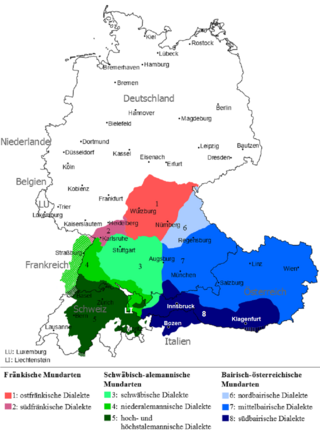
East Franconian or Mainfränkisch, usually referred to as Franconian in German, is a dialect which is spoken in Franconia, the northern part of the federal state of Bavaria and other areas in Germany around Nuremberg, Bamberg, Coburg, Würzburg, Hof, Bayreuth, Meiningen, Bad Mergentheim, and Crailsheim. The major subgroups are Unterostfränkisch, Oberostfränkisch and Südostfränkisch.

Tauberbischofsheim is a German town in the north-east of Baden-Württemberg on the river Tauber with a population of about 13,200. It is the capital of the Main-Tauber district. It is a popular tourist destination due to its numerous historical buildings, including substantial remains of the medieval town fortifications.

The Franconian Circle was an Imperial Circle established in 1500 in the centre of the Holy Roman Empire. It comprised the eastern part of the former Franconian stem duchy—roughly corresponding with the present-day Bavarian Regierungsbezirke of Upper, Middle and Lower Franconia—while western Rhenish Franconia belonged to the Upper Rhenish Circle. The title of a "Duke of Franconia" was claimed by the Würzburg bishops.
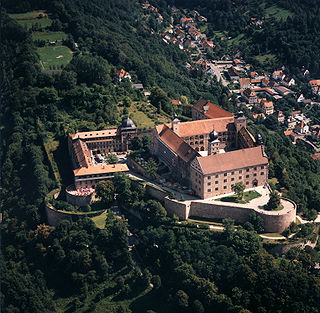
Plassenburg is a castle in the city of Kulmbach in Bavaria. It is one of the most impressive castles in Germany and a symbol of the city. It was first mentioned in 1135. The Plassenberg family were ministerial of the counts of Andechs and used as their seat the Plassenburg. The House of Guttenberg, a prominent Franconian noble family, traces its origins back to 1149 with a Gundeloh v. Blassenberg (Plassenberg). The name Guttenberg is derived from Guttenberg and was adopted by a Heinrich von Blassenberg around 1310. From 1340, the Hohenzollerns governed from Plassenburg castle their territories in Franconia till 1604. The Plassenburg was fortress and residence for the Hohenzollerns.

The House of Bibra was one of the leading Uradel families in Franconia and present day Thuringia from the mid-15th century to about 1600. Later on the family rose from Reichsritter to Reichsfreiherr. After the Holy Roman Empire dissolved, they were made ‘’Freiherr’‘ (Barons) of Bavaria and Bohemia.

Franconia is a German wine region, mostly in north west Franconia. It is the only wine region in the federal state of Bavaria. In 2014, vines were grown on 6,176 hectares of land in the region.
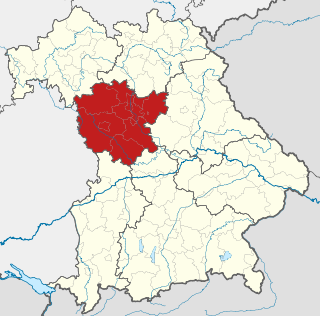
The Bezirksoberliga Mittelfranken was the seventh tier of the German football league system in the Bavarian Regierungsbezirk of Middle Franconia. Until the introduction of the 3. Liga in 2008 it was the sixth tier of the league system, until the introduction of the Regionalligas in 1994 the fifth tier.

Gau Franconia was an administrative division of Nazi Germany in Middle Franconia, Bavaria, from 1933 to 1945. Before that, from 1929 to 1933, it was the regional subdivision of the Nazi Party in that area. Originally formed as Middle Franconia in 1929, it was renamed Franconia in 1936.

Rotenhan Castle is a castle ruin about two kilometres north of the village of Eyrichshof in Lower Franconia in the south German state of Bavaria. Eyrichshof lies within the borough of Ebern in the district of Haßberge. The castle is the ancestral home (Stammsitz) of the House of Rotenhan, a family of imperial knights.
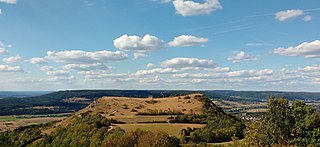
The Ehrenbürg is a double-peaked butte on the edge of the Franconian Jura in Bavaria, Germany. It is in the district of Forchheim in Upper Franconia, in the municipalities of Kirchehrenbach, Leutenbach and Wiesenthau. The north peak is the 513.9 m Walberla, the south peak the 531.7 m Rodenstein. The hill is popularly known as the Walberla.

On 8 March 1988 the Bavarian State Ministry for State Development and the Environment designated an area of 1,280 square kilometres (490 sq mi) in the Steigerwald in North Bavaria, Germany, as the Steigerwald Nature Park. About half the area consists of protected landscapes. The nature park is run by the Steigerwald Tourist Association and Steigerwald Nature Park.
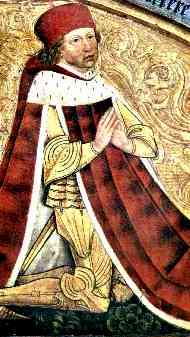
The Dispositio Achillea was the disposition of the territories of Elector Albert III Achilles of Brandenburg as regulated in his last will and testament of 1473.
Horst Wolfgang Böhme is a German archaeologist with a focus on Late Antiquity / Early Middle Ages and research into castles.

The Franconian Rake is the name given to the coat of arms of the region of Franconia in Germany. It is described heraldically as per fess dancetty of three points gules and argent. The points represent a stylised heraldic rake.

The Franconian flag is a symbol of Franconia, a region in North Bavaria and parts of Thuringia, Hesse and Baden-Württemberg in Germany.

Franconia is a region that is not precisely defined, but which lies in the north of the Free State of Bavaria, parts of Baden-Württemberg and South Thuringia and Hesse in Germany. It is characterised by its own cultural and linguistic heritage. Its history began with the first recorded human settlement about 600,000 years ago. Thuringii, Alemanni and Franks, who gave the region its name, settled the area in the Early Middle Ages. From the mid-9th century, the Stem Duchy of Franconia emerged as one of the five stem duchies of the Empire of East Francia. On 2 July 1500, during the reign of Emperor Maximilian I, as part of the Imperial Reform, the empire was divided into Imperial Circles. The Franconian Circle, which was formed as a result of this restructuring, became decisive in the creation of a Franconian national identity. A feature of Franconia in the Middle Ages and Early Modern Period was its Kleinstaaterei, an extreme fragmentation into little states and territories. In the 19th century under Napoleon, large parts of Franconia were incorporated into the newly created Kingdom of Bavaria.
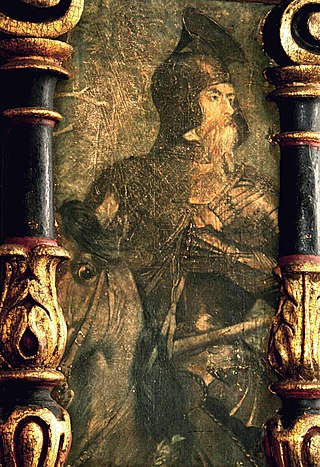
The Franconian War was waged in 1523 when the Swabian League attacked several robber baron castles in Franconia, whose nobles were supporters of Hans Thomas of Absberg in the Absberg Feud.

The Party for Franconia also known as Frankenpartei is a minor party in Germany aimed primarily at people in the Franconian regions of Bavaria.


















